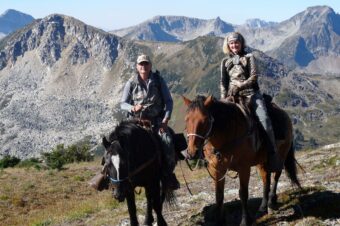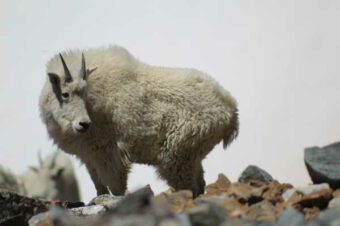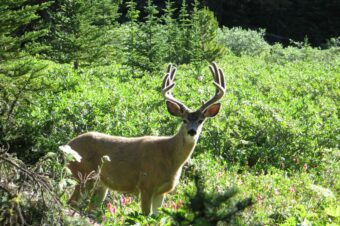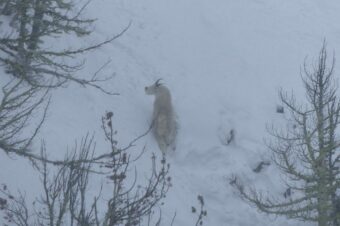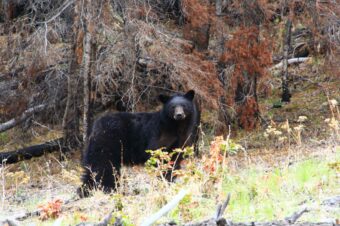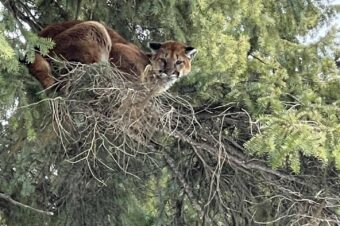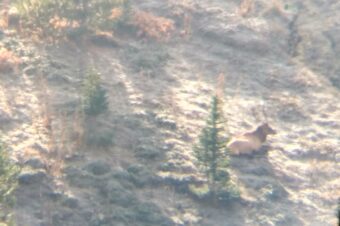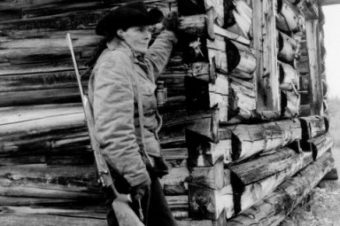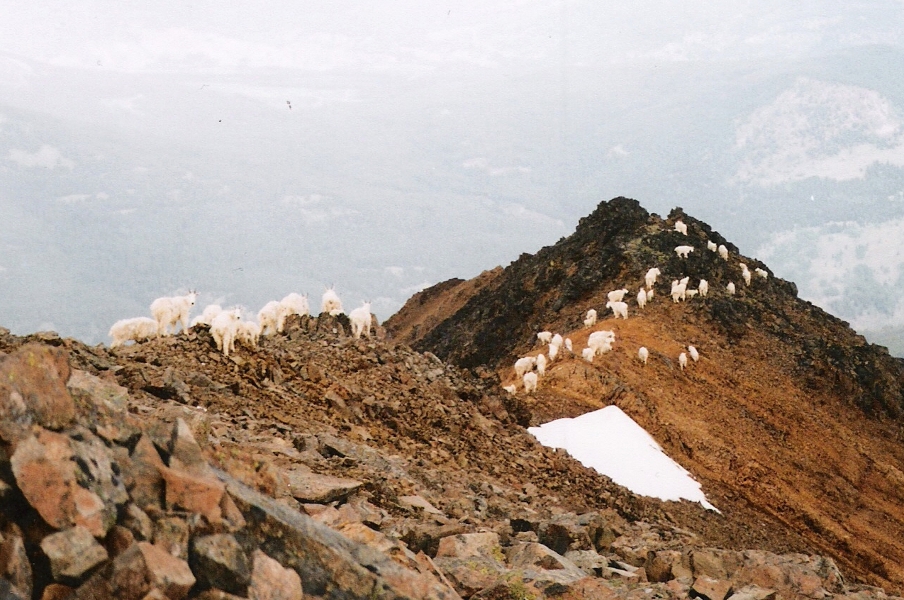
BCTMO Conservation Club works closely with other businesses and conservation groups in the Chilcotin Ark. It is this connection that allow us to self-finance our conservation efforts based on environmental, social, governance criteria. Since we live and do business in the Chilcotin Ark, a unique ecosystem with high biodiversity, we are responsible for its conservation, by looking after the environment we benefit from. Driven by the understanding that we need to conserve the Chilcotin Ark to ensure that the benefits for wildlife, plants and people continue into perpetuity, and contribute to something bigger than ourselves, these are the conservation projects we worked on so far in 2022:
Ungulate enhancement with black bear hunts
Our spring bear hunts are important for ungulate enhancement as this is the time of year when California Bighorn sheep lambs, mule deer fawns, moose calves and mountain goat kids are most vulnerable to predation. Keeping black bear numbers in check helps enhance the ungulate population. Black bears eat one newborn animal a day over a two week period. Want to book your spring black bear hunt and make your contribution to conservation? Book your hunt here: https://www.bctrophymountainoutfitters.com/conservation-hunts/big-game-species/black-bear/
Ungulate enhancement with cougar hunts
Cougar hunts are important in winter as this is when ungulates are concentrated in their winter range. With deep snow, it is harder for them to escape predators. As cougars often specialize on a species, one of our California Bighorn sheep herds is particularly vulnerable as they are in an easy-access location for the cougars. Cougars eat one animal a week year round. Want to book your cougar hunt and contribute to conservation? We are hunting cougar until February 15th or later, depending on the weather. Book here: https://www.bctrophymountainoutfitters.com/conservation-hunts/big-game-species/cougar/
Ungulate enhancement with wolf hunts
Wolf hunts are also important in winter as the wolves chase ungulates (mostly mule deer and California Bighorn sheep) onto a frozen lake. With hooves, the ungulates can’t get a good traction on the ice, but the wolves can giving them an advantage. We hunt wolves until the end of February and early march, depending on the weather. So if you’d like to make your contribution to conservation, book your winter wolf hunt here: https://www.bctrophymountainoutfitters.com/conservation-hunts/big-game-species/grey-wolf/
Hunt philosophy
Our harvest numbers are dictated by the population numbers for each species. With our conservation efforts, we work to maintain species numbers at the maximum population size for the habitat’s potential carrying capacity.
Sharing the meat with local First Nations, guests and staff
Many of our hunters can’t take all their meat home with them so we share this meat with local First Nations, guests and staff. This is particularly important for our summer eco-tour guests as we educate them about wildlife, wild harvest, living in harmony with the land and conservation hunting. We share the meat with local First Nations and our guides which means lots of people get to benefit from the wild harvest. When we give the meat away, we send with it a story about how the meat was harvested and a recipe to ensure it is cooked right so it can be enjoyed safely. When cooking for our guests, our average roast of wild game weighs a pound and feeds 6-10 people as a taster dish. With forty pounds of meat coming from a goat, that provides an educational treat for 400 people from each animal.
Chapter donations for conservation
Every year we donate hunts to chapters mostly in the US, but also in Canada and internationally. This contributes to international conservation as the funds generated from these donations are used for conservation both in the Chilcotin Ark and internationally as the funds are used by that chapter in their area.
5% conservation contribution
We have a 5% conservation contribution for hunters charged as part of their hunt. Hunters that come for more expensive hunts pay more towards conservation. This is one way that we self-finance our conservation work. Thank you to all our hunters for their conservation contribution. All the projects highlighted in this newsletter are funded by your conservation contribution.
On the ground data collection
As every year for over 30 years, we have been filling in wildlife sightings forms, grass assessments, creel reports and white bark pine assessments as well as collecting blood samples from harvested animals, grizzly hair and mountain goat feces for DNA with our guests to build up our database and show them how they can get involved in conservation. We empower them to become wilderness stewards, experience a nature connection and invest in their personal development. The data collected is used to inform us about how actual population numbers relate to the carrying capacity and is used to determine our population management and by local government. https://docs.google.com/forms/u/1/d/e/1FAIpQLSeAJ5jg0_B8rNOsidwTJo5XT5PHCoklMwKxG9tw8Zn9hoF-8w/viewform?usp=sf_link
White bark pine cone collection
Last year we collected 100s of white bark pine cones while on the trail to use for propagation and planting in areas where the white bark pine isn’t thriving like it is in the Chilcotin Ark. This year we shelled all the pine cones ready to be propagated. We estimate we sent 20,000 white bark pine nuts to the White Bark Pine Ecosystem Foundation for them to propagate and plant. Collecting data about the pine trees from trips is also used for research and creating and maintaining sustainable land management.
New hunt guides
This year we had seven new guides complete their assistant hunt guide test, learning about responsible hunting guiding, being wilderness stewards and all the regulations. Four of these new guides were women, inspired by Gerry Bracewell, famous female guide outfitter and local legend. Read her story here: https://www.bctrophymountainoutfitters.com/gerry-bracewell-local-legend/
Chilcotin Ark
BCMTO Conservation Club is linked to from the Chilcotin Ark website. The website, chilcotinark.org, educates people about the virtues of the Chilcotin Ark and why it is important to conserve it. The website includes the top ten virtues of the Ark, all the businesses, conservation organizations, communities and First Nations in the Ark and ways for people to get involved in its conservation. The work with the Chilcotin Ark is generally focused on educating the public about the area and empowering them to take responsibility for the stewardship of the Ark.
Chilcotin Ark marketing material
BCTMO Conservation Club has made use of the Chilcotin Ark’s marketing material to educate our guests about the about the importance of the Ark. The brochure about the Chilcotin Ark’s ten features encourages readers to check out the Chilcotin Ark website to find out more. The two Chilcotin Ark posters, one featuring mountain goats and the other a grizzly sow with four cubs, highlight two of the important species of the area. These posters are available to download on the Chilcotin Ark website to help people spread the word and get involved.
Conservation signs
BCTMO Conservation Club supported local efforts to educate the public about the conservation of the Chilcotin Ark and were happy to see the following signs in our guide territory. The Chilcotin Ark sign welcomed people to the area but encouraged them to take responsibility for it. It also links to the Chilcotin Ark website for more information. The 1500m no fly zone signs educated helicopter and fixed wing aircraft about the regulations to not fly closer than 1500m to mountain goat habitat to avoid displacing the animals. The harvest billies only signs educated resident hunters about the importance of only harvesting billy goats due to the sensitive nature of mountain goats to female harvest. RAPP (Report All Poachers and Polluters) signs encourage responsible and legal hunting from resident hunters. No motorized vehicles in the alpine signs keep ATVs out of wildlife summer range habitat.
#chilcotinark
#chilcotinark has been used on Facebook and Instagram in the last few years, but it is now gaining popularity on social media. Our guests are using this hashtag and sharing set posts from the Chilcotin Ark website on social media. When sharing your adventures in the Chilcotin Ark on social media don’t forget to use #chilcotinark.
Chilcotin Ark map orientation
We added a map of the Chilcotin Ark and created a new map orientation to go with it. This talks about the top ten virtues and educates our guests about the conservation work we do. Now all our hunters can see how their hunt fits into the bigger conservation picture.
Logging and habitat management
We are on the ground 365 days a year and so get to know our wildlife and habitats very well, but we are also constantly learning more. That’s why we work with local woodlots and logging companies for habitat enhancement, the creation or preservation of suitable habitat for ungulates and wildlife conservation. We also educate them about our conservation work and give them the opportunity to fund these or participate in them, helping them to fulfill their ESG responsibilities. One of the conservation opportunities we talked about was deactivating logging roads in critical wildlife habitat such as mule deer winter range to 1/2 km of road per km2 of area.
Referrals
Snowmobiling
A snowmobile company was applying for a tenure in the south corner of the Chilcotin Ark. On reading their application it became clear they hadn’t accurately assessed the impact on mountain goats, moose and grizzly bears and also hadn’t consulted with the local First Nations and businesses. We recommended the company reassess the impact on wildlife and consult with all stakeholders before their application can move forward.
Helicopter Use
We noticed an increased use of helicopters in the park and not following regulations such as maintaining a 1500m no fly zone from mountain goat habitat and fuel tanks being more than 2000m away from mountain goat habitat. Taking responsibility for the conservation of the area, we contacted the government using their online violation reporting tool to make them aware of these issues that impact the mountain goat population.
Back-country skiing and snowboarding application
This company was updating their License of Occupation and wanted to apply for a small intensive use site for their sauna building near their lodge. We had no objections to this proposal as it had no conservation issues and the company followed proper procedure.
Lake front lodge by BC Parks
A small lodge was planned to be built by BC Parks on the edge of one of the lakes in our guide territory. This became a very contentious issue between BC Parks and cabin owners on the lake and in conflict with conservation and stewardship of the area. As of yet no solution has been found.
Proposed development of horse and hike trail into an ATV trail
This trail is a narrow trail to the alpine which used to be used by horse riders and hikers who have since been mostly alienated by mountain bike users. Now, the plan to develop it would allow ATV access right to the alpine. This would greatly impact bears, mule deer and mountain goats that would be displaced from their prime habitat. It would also further alienate horse and hike users due to the danger of an encounter with a motorized vehicle. This proposal was put on hold.
Thanks to all our hunters for your contribution to the conservation of the Chilcotin Ark so far. Are you ready to do more and create a positive impact long into the future? Want to be involved in something bigger than yourself and contribute to the conservation of the Chilcotin Ark? Book your next conservation hunt in the Chilcotin Ark: https://www.bctrophymountainoutfitters.com/conservation-hunts/
You can be a wilderness steward either in person or online. Check out the Chilcotin Ark and Chilcotin Ark Institute websites for all the ways you can make your contribution. https://www.chilcotinark.org/become-a-chilcotin-ark-steward/ and https://chilcotinarkinstitute.com/get-involved/
